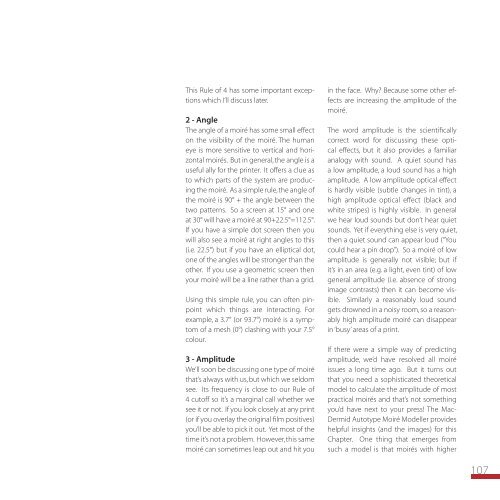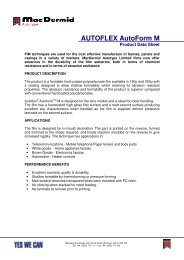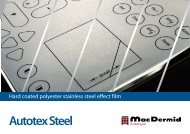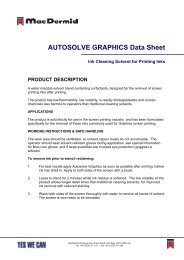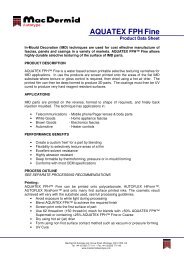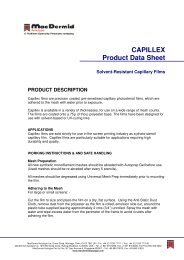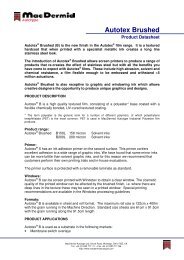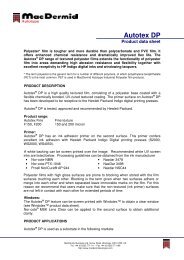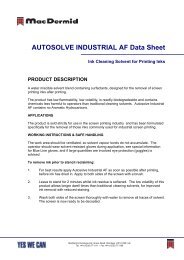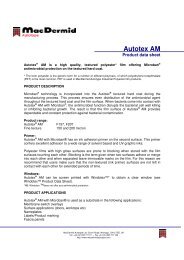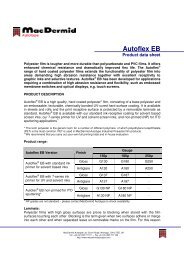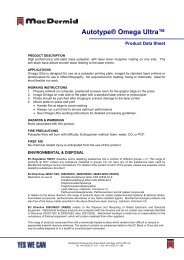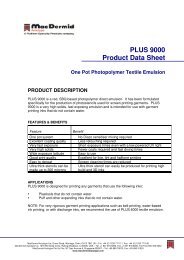Screen E-Book (.PDF) - MacDermid Autotype
Screen E-Book (.PDF) - MacDermid Autotype
Screen E-Book (.PDF) - MacDermid Autotype
- No tags were found...
Create successful ePaper yourself
Turn your PDF publications into a flip-book with our unique Google optimized e-Paper software.
This Rule of 4 has some important exceptionswhich I’ll discuss later.2 - AngleThe angle of a moiré has some small effecton the visibility of the moiré. The humaneye is more sensitive to vertical and horizontalmoirés. But in general, the angle is auseful ally for the printer. It offers a clue asto which parts of the system are producingthe moiré. As a simple rule, the angle ofthe moiré is 90° + the angle between thetwo patterns. So a screen at 15° and oneat 30° will have a moiré at 90+22.5°=112.5°.If you have a simple dot screen then youwill also see a moiré at right angles to this(i.e. 22.5°) but if you have an elliptical dot,one of the angles will be stronger than theother. If you use a geometric screen thenyour moiré will be a line rather than a grid.Using this simple rule, you can often pinpointwhich things are interacting. Forexample, a 3.7° (or 93.7°) moiré is a symptomof a mesh (0°) clashing with your 7.5°colour.3 - AmplitudeWe’ll soon be discussing one type of moiréthat’s always with us, but which we seldomsee. Its frequency is close to our Rule of4 cutoff so it’s a marginal call whether wesee it or not. If you look closely at any print(or if you overlay the original film positives)you’ll be able to pick it out. Yet most of thetime it’s not a problem. However, this samemoiré can sometimes leap out and hit youin the face. Why? Because some other effectsare increasing the amplitude of themoiré.The word amplitude is the scientificallycorrect word for discussing these opticaleffects, but it also provides a familiaranalogy with sound. A quiet sound hasa low amplitude, a loud sound has a highamplitude. A low amplitude optical effectis hardly visible (subtle changes in tint), ahigh amplitude optical effect (black andwhite stripes) is highly visible. In generalwe hear loud sounds but don’t hear quietsounds. Yet if everything else is very quiet,then a quiet sound can appear loud (“Youcould hear a pin drop”). So a moiré of lowamplitude is generally not visible; but ifit’s in an area (e.g. a light, even tint) of lowgeneral amplitude (i.e. absence of strongimage contrasts) then it can become visible.Similarly a reasonably loud soundgets drowned in a noisy room, so a reasonablyhigh amplitude moiré can disappearin ‘busy’ areas of a print.If there were a simple way of predictingamplitude, we’d have resolved all moiréissues a long time ago. But it turns outthat you need a sophisticated theoreticalmodel to calculate the amplitude of mostpractical moirés and that’s not somethingyou’d have next to your press! The Mac-Dermid <strong>Autotype</strong> Moiré Modeller provideshelpful insights (and the images) for thisChapter. One thing that emerges fromsuch a model is that moirés with higher107


